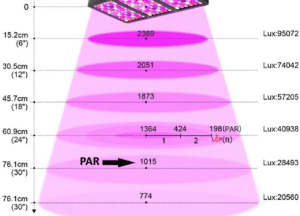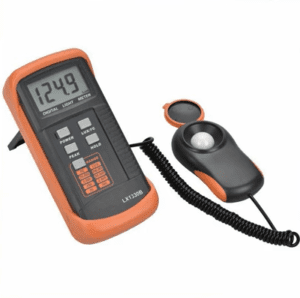Today we are doing an episode about face value and face range, and what kind of gathering your plant needs at each stage of its life. I have made an episode on Lux in the past. The article explains, but I think I have to do a complete set and talk about par, because many people today do not use Lux, and LED lighting manufacturers also seem to prefer to show their lighting capabilities by displaying their par readings at a certain height.
As you can see in the example image here, it seems that Lux is at least slowly disappearing, at least for indoor growers, photosynthetically active radiation is a plant-specific method that only measures what the plant can actually use for photosynthesis Light, and the lumens usually expressed on a certain surface area of Lux is just a more general measure of the overall light intensity without considering the factors related to photosynthesis. This makes the photometric measurement of indoor gardens more accurate, because lumens and lux are still widely used. The reason for use is basically well applied. This is because the cost of a luxury meter is only one tenth of its cost, so many growers only use Lux, especially when you use an outdoor grower, the sun Can provide very good performance, so you really don't have to worry, but anyway, if you want to view them, you can link to a parameter table and a link to an illuminance meter in the video description.
The ppfdor photosynthetic photon flux density is just a way to express the same level. It is actually a unit measured in micromoles per square meter per second, ppfdis. It is just the number of readings displayed in meters at the same level. Therefore, this is what you want during the growth Although God knows that you may go far and high, it just means that the growth rate slows down, and so on. For your seedlings, clone the mother plant, your plant nutrition will reach 1 250 to 400 ppfd ceplants, you want 400 to 600 ppfd, flowering plants, you will need 16 to 900 ppfd, but for your leisure growers, don’t worry, if you are below 600 ppfd, you will still get growth. You will still get that the rate of production decline will not be so fast or so fast. Some of you indoor growers always want to know, if I can be taller like the above athousand ppfd, can you be taller? For example, we conducted an interesting study at the University of Mississippi in 2008, which proved that the dominant plant of asativa originated in Mexico. As long as the air temperature is kept below 30 degrees Celsius, the strain that can withstand its light intensity will actually be 1500 ppfd. The speed increases sharply, but the higher the temperature rises by 1000 ppdd, the less profit is gained for each additional point, and the more difficult it is to increase access, the more you own, you either have more growth lights, or you have Better grow lights, or make existing grow lights closer to the plants, which of course will lead to the first method of taking more kinds of plant growth light may also cause you to heat up, and remember that as an indoor grower, you The role of is usually to grow the most efficient plants, not the fastest way to grow plants, and in the fastest way of planting, you spend the most money is the best.
The rule of thumb is that if your price exceeds 950 to 1,000 ppfd, your economic efficiency is not high. Even if you use high-efficiency LED lights, I don’t know why the University of Mississippi has done so much research on cannabis. They are even those People who have been engaged in pattern monitoring projects for decades, maybe I have to interview someone from there, because I really want to know why in such a state with such a retrospective history of cannabis, you have a university that has done all of it so well. The research, this is the powerful force of my quick start guide, I hope you find it useful.






